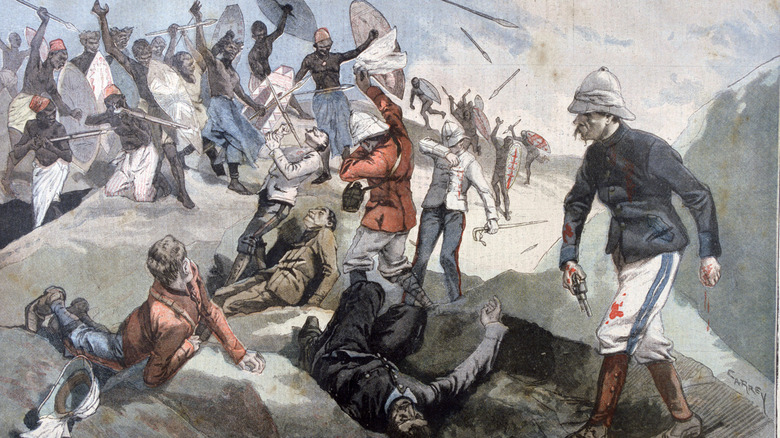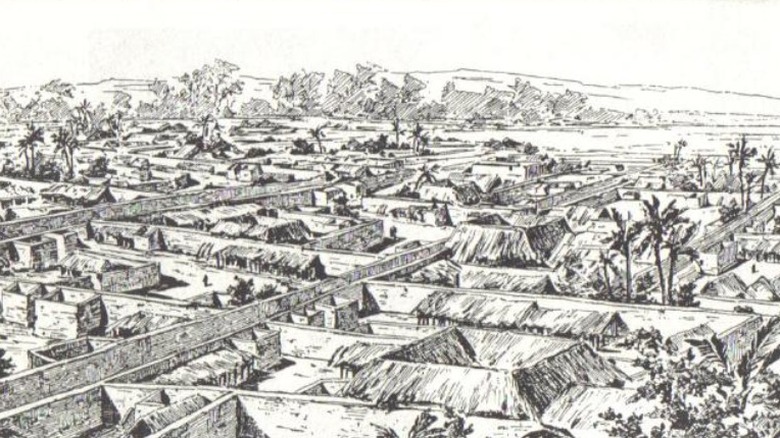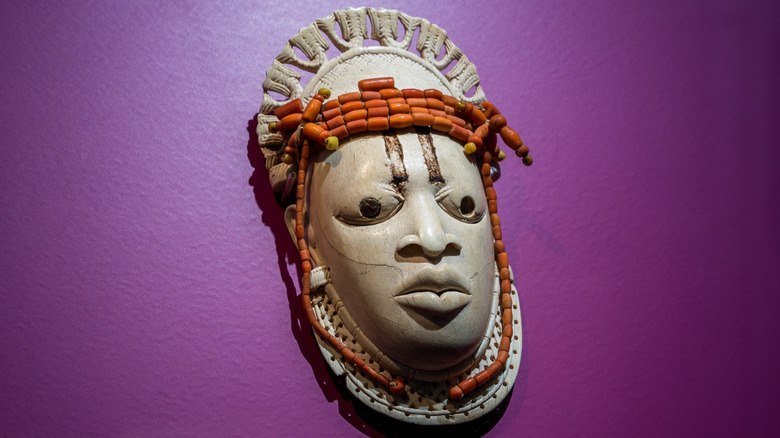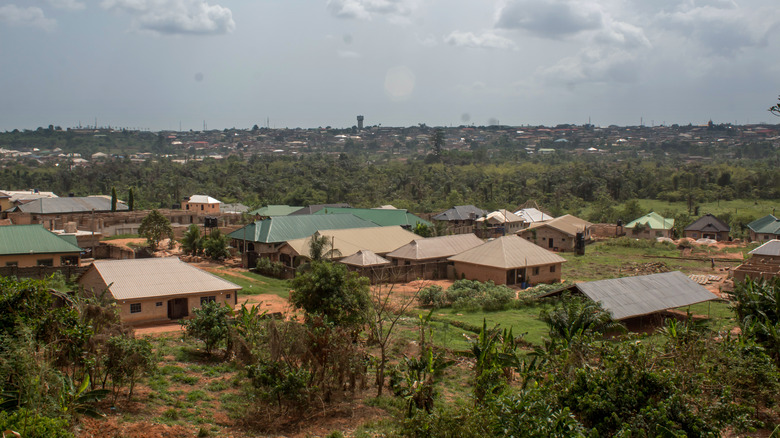The Untold Truth Of Benin City
Prior to the year 900, the location of today's Benin City was a dense and inhospitable rainforest. However, by the dawn of the new century, the Edo people began clearing the rainforest and eventually building homes on the land. As reported by BBC, their newly formed kingdom, Igodomigodo, was ruled by kings — who were called Ogisos, or "rulers of the sky."
Over the next 200 years, the Igodomigodo Kingdom thrived but the Edo people became disenchanted with the Ogisos. By the 1100s, the Edo people gained independence from the Ogisos. However, they realized they still needed a leader. Beginning in the 1100s, the Edo people were led by a series of Obas, which remain an important part of Benin City's leadership to this day.
With the appointment of their first Oba, the Igodomigodo Kingdom became the Benin Kingdom and, as reported by BBC, grew to become the Benin Empire.
Between 1440 and the late 1800s, the Benin Empire thrived and became a successful center for trade. As reported by National Geographic, Benin was also known for its unique architecture, bronze sculptures, and practical infrastructure.
The Benin Empire was ultimately destroyed during the Benin Punitive Expedition of 1897. During the expedition, Benin was decimated and burned to the ground. The land, which is presently part of southern Nigeria, remained under British control until 1960.
Black Past reports Benin City is once again thriving. However its rich, and somewhat unusual, past, remains an intriguing part of its legacy.
Benin City's walls were longer than those of the Great Wall of China
In 1974, the Guinness Book of Records recognized the historic Benin City for its extensive network of walls, which surrounded the entire kingdom and divided it into nearly 500 separate villages. As reported by The Guardian, the walls were largely destroyed during the Benin Punitive Expedition of 1897, and no known trace of the walls remain in the modern Benin City. However, prior to 1897, the network of walls was nearly 10,000 miles in total length and enclosed more than 4.000 square miles of land. The walls around the perimeter of the kingdom were also surrounded by deep moats, which provided Benin with another degree of protection
The Guardian reports Benin's walls were "four times longer than the Great Wall of China, and consumed a hundred times more material than the Great Pyramid of Cheops," and reportedly took the Edo people an "estimated 150 million hours" to complete. The Guinness Book of Records noted Benin's walls were "the world's largest earthworks prior to the mechanical era."
As reported by This is Africa, Benin's walls provided a border around the empire and boundaries for its villages for over 400 years before they were destroyed in the British invasion. Although rumors suggest a portion of one of the walls remains intact, hidden in the Nigerian bush, it is unlikely — as there was no effort to preserve or restore any of the remnants left standing following the Punitive Expedition.
Daily life in Benin City
Contrary to the British troops' description of the Benin Kingdom, other visitors described the city as civilized and clean. As reported by The Guardian, Benin city was virtually free from crime, and its residents never went hungry.
Portuguese captain Lourenco Pinto, who visited Benin City in 1691, said "Great Benin ... is larger than Lisbon; all the streets run straight and as far as the eye can see. The houses are large ... The city is wealthy and industrious. It is so well governed that theft is unknown and the people live in such security that they have no doors to their houses."
The Guardian reports residents kept their homes extraordinarily clean. However, they also took great pride in their city. Each of the city's 11 divisions included workshops, where artisans created sculptures, cast bronze plaques, and carved ivory. The artwork was displayed in galleries and used to decorate homes and public buildings. Residents also appointed judges or moderators to settle disputes and to maintain overall civility.
Historians believe residents often dressed in bright colors, primarily blue, green, and yellow. They regularly gathered together to create artwork, visit galleries, and have lively debates. The residents also participated in Benin City's prosperous trade market.
As reported by The Guardian, the residents were likely active in the evenings, as the streets were outfitted with street lights fueled with palm oil.
Benin City was built using fractal design
Not only did Benin City have an incredible network of walls, but the entire city was also built using fractal design. As reported by The Guardian, mathematical patterns were apparent throughout Benin City, from the length and arrangement of the streets to the shape and size of the buildings.
Initially, Europeans who visited the city described it as "disorganized." However, upon further inspection, they realized there were clear patterns in the architecture and the actual layout of the city.
The Guardian reports the king's court was in the direct center of Benin City. From the center, 30 streets, which were approximately 120 feet wide, extended out at right angles like the spokes of a wheel. In addition to being notably straight, the roads were built with ditches and outlets that carried stormwater away from the city.
The smaller side streets were also built in mathematical patterns. Interestingly, the side streets were built with strips of turf in the middle — to provide somewhere for animals to graze.
Benin City's family homes were also built using fractal design. As reported by The Guardian, each home had three sections. The main room of the house, which was in the center, was the husband's quarters, the wives' quarters were to the left of the main quarters, and the young men's quarters were on the right. Each home was also outfitted with a well, which provided the family with fresh water.
Rumors of human sacrifice haunt Benin City
Amid the British Punitive Expedition, Commander R. H. Bacon disputed reports that Benin was a productive, modern, and civilized city. In The Slave Trade, Depopulation and Human Sacrifice in Benin History, author James D. Graham recounts Commander Bacon's impression of Benin City.
According to Bacon, the town was rife with "crucifixions, human sacrifices, and every horror the eye could get accustomed to ... blood was everywhere; smeared over bronzes, ivory, and even the walls." The book also alleges, "There is little doubt that human sacrifices were an integral part of the Benin state religion from the very early days."
One of the most notorious of Benin City's sacrifices was Queen Iden, who was the wife of Oba Ewuape. As reported by Google Arts and Culture, Oba Ewuape faced harsh criticism and rebellion from the kingdom and chiefs almost immediately after his appointment.
Religious leaders suggested a human sacrifice would help restore order to the kingdom. In an attempt to bring her husband peace, and secure his position as Oba, Queen Iden offered herself to be sacrificed.
Google Arts and Culture reports Queen Iden was, and is, considered a hero for the sacrifice she made for the betterment of Benin city. Her tomb is still displayed near the Oba market in Benin City.
It is unclear how common human sacrifice was in Benin City, and as reported by Vanguard, current Obas have denied it was ever part of the culture.
Whatever happened to Benin City?
Following the Punitive Expedition of 1897, Benin City remained under British control for more than 60 years. However, it gained independence in 1960 and became the capital of Edo state in 1963. As reported by Black Past, little, if anything, remains of the legendary Kingdom of Benin. However, today's Benin City remains one of Nigeria's most prosperous centers of trade.
The Guardian reports one home, which is called Chief Enogie Aikoriogie's house, is believed to be the only known structure to survive the Punitive Expedition. Although the specific age of the home is unknown, the architectural style suggests it was built in the mid to late 1800s.
As reported by Black Past, Benin City still has an Oba, who fulfills a traditional cultural role and participates in local and federal governmental proceedings. Although it was built after the Punitive Expedition of 1897, Benin's Royal Palace of the Oba is officially listed as one of Nigeria's heritage sites. Keeping with tradition, the palace is situated in the center of the city.
In 2016, the population of Benin City was estimated to be 1,500,000. In addition to being the fourth-largest city in Nigeria, Benin is the largest city in Edo state.
Benin City has a renowned teaching hospital and a number of factories. It remains an important source of palm kernels, palm oil, and lumber. The city also manufactures furniture and produces beer and soft drinks.





